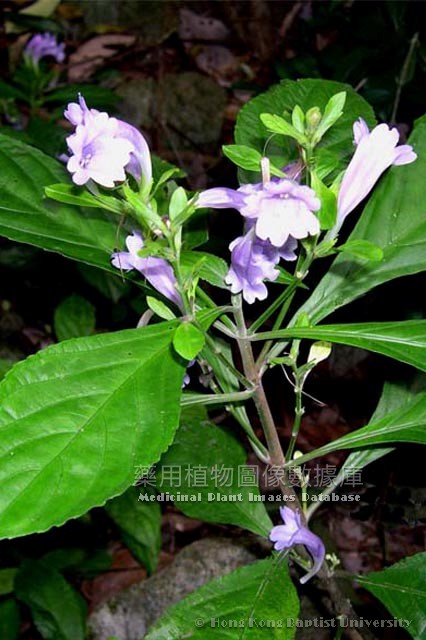|
Baphicacanthus cusia (Nees) Bremek.

|
English Name |
Flaccid Conehead, Common Baphicacanthus, Conehead, Common Conehead |
|
Latin name |
Baphicacanthus cusia (Nees) Bremek. |
|
Family & Genus |
Acanthaceae, Baphicacanthus |
|
Description |
Perennial herbaceous, ca. 1m tall, shrub-like. Rhizomes stout, section blue. Stem erect, node prominent, blunt ribbed. Leaves opposite; petiole 1-2cm long; blade obovate-elliptic or ovate-oblong, 5-16cm long, 2.5-6cm wide; apex acute, slightly obtuse, base attenuate, margin slightly serrated, glabrous above, slightly hairy on the underside when young, lateral veins 5-6 pairs, stem and leaves blue or dark green when dry. Spikes terminal; bracts are leaf-like, narrow obovate, 1-2cm long, caduceus; calyx 5 divided, 4 acicular, 1-1.4cm long, rest larger, spoon-shaped, glabrous; corolla funnel shaped, pale purple, 4.5-5.5cm long, 5 lobes, lobes short and wide, apex obtuse; stamens 4, didynamous, borne at upper part of corolla tube, pollens elliptic; pistil superior ovary, style slender. Capsules, 1.5-2cm long. Seeds 4, pubescent. Flowering: June to October, fruiting: July to November. |
|
Distribution |
Growing in mountains, forest edges and humid places. Can be cultivated. Distributed in Jiangsu, Zhejiang, Fujian, Hubei, Guangdong, Guangxi, Sichuan, Guizhou, Yunnan and etc. The medicinal materials are mainly produced in Fujian, Sichuan, Yunnan and etc. |
|
Part Used |
Medical part: rhizomes and roots, powder or clumps processed form leaves or stem. Chinese name: rhizomes and roots: Nanbanlangen; processed powder or clumps: Qingdai. |
|
Harvest & Processing |
Nanbanlangan: excavated in summer and autumn, removed aboveground stem, washed and sun-dried. Qingdai: cut off leaves when plants flourish in summer and autumn, put into vat or barrel, soaked in water for 2-3 days and nights, removed stem and leaf residue, add 4-5kg lime per 50kg leaves, stirred well, until extract turn from black-green to purple-red, got foam-like liquid and sun-dried. |
|
Chemistry |
Contains chrysophanol, β-Sitosterol, indigotin and isatin. |
|
Pharmacology |
Anti-tumor, anti-bacterial and phagocytosis-enhancing. |
|
Properties & Actions |
Nanbanlangan: bitter, sold. Qingdai: salty, sold. Nanbanlangan: root: bitter, cold. Qingdai: salty, cold.Nanbanlangan: clearing heat and detoxifying, cooling the blood and soothing the throat. Qingda: clearing heat and detoxifying, cooling the blood and settling fright. |
|
Indications & Usage |
Nan banlangen: Used for epidemic heat syndrome with eruptions, dark purple tongue, mumps, pharyngitis, scarlet fever, epidemic disease characterized by swelling and redness of face, anthracia, erysipelas. Natural indigo: Used for epidemic heat syndrome with eruptions, vomiting and apostaxis due to heat in blood, Thoracodynia and coughing up blood, sore mouth, mumps, pharyngitis, infantile frightened epilepsy.Nanbanlangen: oral administration: decocting, 10-30g (megadose 90g); or made as pills or powders. External: appropriate amount, decocted for fumigating. Use with care in case of spleen and stomach deficiency-cold. Qingdai: oral administration: decocting, 3-6, wrapped with cloth; powdered, 1.5-3g per time, made as pills or powders. External: appropriate amount, powdered for dusting or after mixed with fluids. Not use in cases of deficient-cold of spleen and stomach. |
|
Examples |
1. Nanisatis root: influenza: isatis root 30g, notopterygium 15g. Decoct, drink in two times a day, for 2-3 days continuously.
2. Natural indigo: red speckles due to typhoid fever: natural indigo 6g. Grind in water and drink. |
| Link to |
 Chinese Medicinal Material Images Database Chinese Medicinal Material Images Database
 Chinese Medicine Specimen Database Chinese Medicine Specimen Database
|
|

